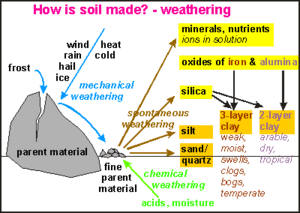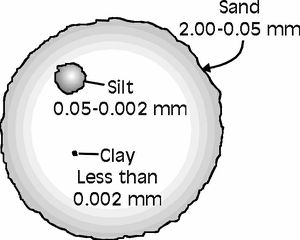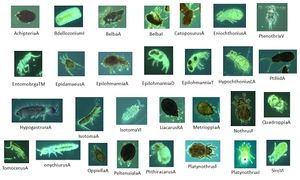Clay
Origins of Clay

Clay is formed from the erosion of a limited variety of environments. Some of these environments include; continental which is weathering and erosion on Earth's surface, marine which occurs on the floor of a body of water, or even within the Earth when it is near a heat source. The heat source would be magma, and there would have to be water in the pores of the rocks and minerals under the crust of the Earth. When the situations are right the clay is formed by the breaking down of the minerals. Clay can include any minerals of the rocks that it breaks down to form clay soil but there has to be some minerals in it that are able to absorb water. In order for something to be a considered a clay it also has to be smaller than 0.002mm. There are 2 main types of clay residual and sedimentary clays. When clay is formed there is the chemical decomposition of feldspar.
Characteristics of Clay

For something to be considered clay it has to met a few criteria. The grain size of a clay particle has to be 0.002mm or smaller, this means greater surface area, and that the clay particles will be tightly packed. Clay also has to have the ability to absorb water from the soil. Its particles will increase there size greatly when they absorb water, sometimes by nearly 100 percent. Clay has to be made of hydrous aluminum silicates, these are the chemicals that will be able to absorb water. There are other chemicals in clay but they can be made of whatever other material that is available and has also been broken down in erosion and weathering.
Residual Clay
Residual clay is clay that has not been transported away from the parent rock. This type of clay is most often formed from weathering on the earths surface, which can happen in a few different ways. One way is that it can have chemical deposition of rocks, like granite. Another is, solutions of rocks like limestone have impurities but can be deposited as clay. Once this happens residual clay is formed and can then be harvested for different uses. Residual clay is considered to have low plasticity and will not stick together very easily which, limits its uses.
Sedimentary Clay
Sedimentary clay are minerals that broke down from the original parent material, through weathering and erosion. They are then transported by wind, water, ice, or any other mode of transport away from the parent rock. As these particles are being transported the are suspended in the water because they are so small. They will only be deposited when the clay particles bump into each other causing them to stick together and sink down to the bottom of the river. When they get moved there are eroded further causing them to decrease in there size. This type of clay is considered to have more plasticity this means it will form a sticker soil.
Organisms That Live in Clay

Clay is not very suitable for many plants to live in, as air has a hard time getting through the soil to the roots because the soil is packed so tightly. There is also a drainage problem with clay dominate soils. Some plants that can tolerate this conditions are coniferous trees such as; pine trees, spruce, balsam fir, and tamarack trees to name a few. Some deciduous trees also can grow in clay dominate soils like; willows, crabapple trees, and some maples. There are also some organisms that live within the predominantly clay soil as well. From, macro-fauna like earthworms and insects to micro-fauna like bacteria, nematodes, and other microscopic organisms can live within clay soil. In order for most things to grow in clay soil you would need to till in peat moss into the soil. Peat moss will increase the carbon content in the soil and help plants to be able to grow much better.

References
"Clay Types, Geology, Properties and Color Chart (GcCeramics) - Meeneecat." Google Sites. N.p., n.d. Web. 14 Apr. 2018.
"Earth Sciences: London's Geology." Clays and Clay Minerals. N.p., n.d. Web. 14 Apr. 2018.
"How Is Clay Formed? Is It Inorganic or Organic?" The Clay Ground Collective. N.p., n.d. Web. 14 Apr. 2018.
"Trees and Shrubs for Clay Soil." Trees and Shrubs for Clay Soil : UMN Extension. N.p., n.d. Web. 14 Apr. 2018.
Environmental Characteristics of Clays and Clay Mineral Deposits. N.p., n.d. Web. 14 Apr. 2018.
Kodama, Hideomi, and Ralph E. Grim. "Clay Mineral." Encyclopædia Britannica. Encyclopædia Britannica, Inc., 20 Feb. 2014. Web. 14 Apr. 2018.